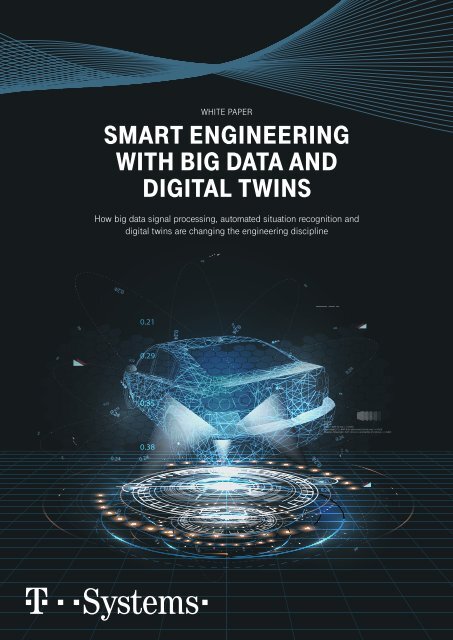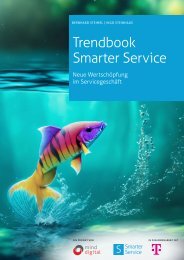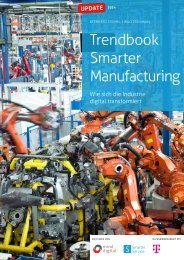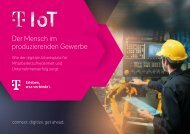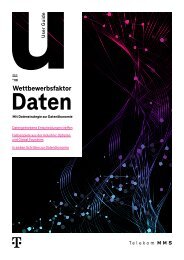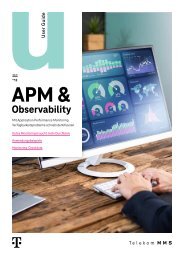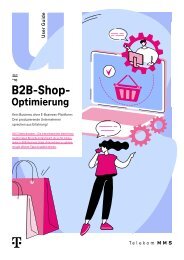4422_WP_Smart_Engineering_EN_web__S.1-x
You also want an ePaper? Increase the reach of your titles
YUMPU automatically turns print PDFs into web optimized ePapers that Google loves.
WHITE PAPER<br />
SMART <strong>EN</strong>GINEERING<br />
WITH BIG DATA AND<br />
DIGITAL TWINS<br />
How big data signal processing, automated situation recognition and<br />
digital twins are changing the engineering discipline
CONT<strong>EN</strong>TS<br />
INTRODUCTION 4<br />
NEW IMPACTS TO <strong>EN</strong>GINEERS 6<br />
NEW METHODS OF DATA HANDLING SPEED UP DEVELOPM<strong>EN</strong>T 8<br />
MORE EFFICI<strong>EN</strong>T MEASUREM<strong>EN</strong>T DATA MANAGEM<strong>EN</strong>T<br />
WITH BIG DATA METHODS 10<br />
DIGITAL TWINS 12<br />
ADDED VALUE VIA SC<strong>EN</strong>ARIO RECOGNITION,<br />
CREATION AND SIMULATION 14<br />
WHO WILL WIN THE RACE? 16<br />
T-Systems International GmbH<br />
Hahnstraße 43d<br />
D-60528 Frankfurt am Main<br />
Authors:<br />
Wolfgang Holz<br />
Dr. Christoph G. Jung<br />
Sascha Leidig<br />
Bastian Wymar<br />
Organisation:<br />
Project manager: Christopher Link<br />
Layout: Peter Brücker/Norman Mascher-Aspensjö
INTRODUCTION<br />
Digitization is changing the world. Technology, innovations and especially<br />
ever-growing data ecosystems are turning the industrial economy on its<br />
head. Markets have long began to adapt to the changing environment<br />
and are remodeling business concepts and rethinking value chains. Data<br />
is the new oil, and an intelligent exploitation of data within industrial processes<br />
and products has become a key success factor for generating new<br />
revenue and optimizing the way value is created.<br />
Manufacturing companies, for example vehicle manufacturers, have a<br />
keen interest in data that provides insights about their products, in this<br />
case vehicle usage, functionalities of digital assistants or quality. Such<br />
data can provide knowledge, that is valuable for developing new services<br />
like autonomous driving. Customer interaction can be improved too, for<br />
example by being able to address drivers in particular situations, such as<br />
when the first indicators for serious wear appear.<br />
Collecting and intelligently analyzing data forms the fundament for all<br />
these activities. In this context, more and more so-called digital twins are<br />
being used, i.e. digital copies of physical objects. These may be vehicle<br />
components or the vehicle as a whole. In vehicle development digital<br />
twins offer particular potential for optimization, for they enable developments<br />
to be largely tested on purely digital simulations. This, in turn,<br />
offers major potential savings in terms of time and money.<br />
Up to now, vehicle parts and control software have been developed, then<br />
tested on many thousands of kilometers of test tracks in order to get<br />
results that can trigger improvements. This process takes several months<br />
and, depending on the outcome of the testing, has to be repeated more<br />
than once until the required vehicle properties and quality requirements<br />
areachieved. Now digital twins can simulate vehicle components in their<br />
real-life contexts, which means they no longer need to be physically produced<br />
or tested on test tracks. Rather, existing test data can be used on<br />
digitally simulated components and thereafter be evaluated. As a result,<br />
engineers get results far more quickly, but at the same time they face<br />
challenges linked to the use of new, digital technologies such as big data<br />
analysis and predictions by artificial intelligence.<br />
The main challenges are the provisioning of suitable hardware and sensors,<br />
the efficient management and processing of gigantic volumes of data and<br />
the development of intelligent analysis algorithms. In this way data can be<br />
converted into insights and then again into design improvements.<br />
The prerequisites for this new type of engineering have been put in<br />
place by the technical innovations of the recent years, for example the<br />
ubiquitous networking, the availability of less expensive hardware and<br />
sensors, and the constantly improving capabilities of data storage and<br />
data processing.<br />
This white paper is aimed at engineers, developers and IT managers who<br />
also face digital engineering challenges. It provides a clear answer to the<br />
question of how big data technologies can be used to improve development<br />
processes in the control software area.<br />
4 5
NEW PARAMETERS FOR <strong>EN</strong>GINEERS<br />
NEW IMPACTS TO <strong>EN</strong>GINEERS<br />
One of the really hot topics in the automotive industry is autonomous driving. Visionary<br />
pioneers like Elon Musk as well as German industry experts talk about a revolution in industry<br />
and society. This means that autonomous driving will not only fundamentally change the<br />
driving experience, it will also change the car as an object to be purchased and used. It will<br />
increasingly turn driving into a mobility service in the personal and commercial transport<br />
sectors. In the sense of the “shared economy”, autonomous driving will make it far easier to<br />
make the car available – autonomously – to other road users as a transport service during its<br />
“downtime”, i.e. when its user is not using it.<br />
However, to enable this type of usage scenario, it is vital that unmanned driving is made as<br />
safe as possible. So the engineering input and software developments along that path occur in<br />
a tense area involving on-board electronics and connectivity, software and smart algorithms in<br />
the vehicle, and communication links between vehicles and an adequate IT infrastructure. This<br />
infrastructure includes smart systems that communicate with vehicles and, for example, offer<br />
and manage services.<br />
As a result, vehicle electronics, on-board sensors and vehicle bus systems are becoming<br />
increasingly complex, while driving functions run autonomously in the car and have to prove<br />
themselves in traffic situations. So, for development, it is important that industry expertise<br />
and digital technology expertise coalesce, i.e. that development teams incorporate digital<br />
engineers working on big data architectures, signal data processing, data management in<br />
data lakes and data analytics. And, secondly, the teams also need to incorporate automotive<br />
engineers working on interpreting data and deriving conclusions as to what the data obtained<br />
says about, for example, the quality of driving functions and driving behaviour, so that control<br />
software can be modified.<br />
In this segment the time-to-market is shrinking rapidly, and the battle to become the first automotive<br />
manufacturer to be able to offer safe autonomous driving has long begun.<br />
Execution speed for continuous software developments, implementation as well as operations,<br />
have now also reached the automotive industry, and it will be a key success factor in the industry’s<br />
future.<br />
6 7


